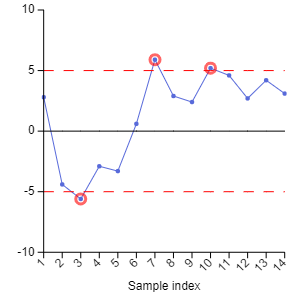import io.data2viz.charts.*
import io.data2viz.charts.core.Padding
import io.data2viz.charts.core.*
import io.data2viz.charts.dimension.*
import io.data2viz.charts.chart.*
import io.data2viz.charts.chart.mark.*
import io.data2viz.charts.layout.*
import io.data2viz.charts.config.configs.*
import io.data2viz.charts.config.*
import io.data2viz.charts.core.CursorType
import io.data2viz.math.*
import io.data2viz.geom.*
import io.data2viz.viz.*
import io.data2viz.color.*
import kotlinx.datetime.Instant
import kotlin.math.*
import kotlinx.browser.document
import org.w3c.dom.*
val width = 450.0
val height = 300.0
data class Value(val index: Int, val value: Double)
val values = listOf(
Value(1, 2.8),
Value(2, -4.4),
Value(3, -5.6),
Value(4, -2.9),
Value(5, -3.3),
Value(6, 0.6),
Value(7, 5.9),
Value(8, 2.9),
Value(9, 2.4),
Value(10, 5.2),
Value(11, 4.6),
Value(12, 2.7),
Value(13, 4.2),
Value(14, 3.1)
)
// just add (then remove) 10 to avoid rounding on "+0" and "-0"
val valuesGroup = values.groupBy { ((it.value + 10) / 5.0).toInt() * 5 - 10 }
val valuesCount = valuesGroup.map { Pair(it.key, it.value.size) }.sortedBy { it.first }
fun main() {
// set a style for placing the CANVAS
val style = document.createElement("style")
style.innerHTML = "canvas{display:inline !important;}"
document.head!!.appendChild(style)
val div = document.createElement("div")
document.body!!.appendChild(div)
// Creating and sizing the VizContainer
val vc1 = (div as HTMLDivElement).newVizContainer()
val vc2 = div.newVizContainer()
vc1.apply { size = Size(width * 0.666, height) }
vc2.apply { size = Size(width * 0.333, height) }
div.setAttribute("style", "height: ${height}px;width: ${width}px")
val chart1 = vc1.chart(values) {
config {
cursor {
show = true
type = CursorType.Vertical
}
events {
highlightMode = HighlightMode.None
}
}
val indexDim = discrete( { domain.index } ) {
name = "Sample index"
}
val valueDim = quantitative( { domain.value } )
val lowDim = valueDim.child( { -5.0 } )
val meanDim = valueDim.child( { .0 } )
val hiDim = valueDim.child( { 5.0 } )
line(indexDim, valueDim) {
showMarkers = true
markDecorator = { datum, position, drawingZone ->
defaultMarkDecorator(datum, position, drawingZone)
if (abs(datum.domain.value) > 5.0) {
drawingZone.circle {
x = position.x
y = position.y
radius = 5.0
strokeWidth = 3.0
strokeColor = Colors.Web.red.withAlpha(60.pct)
}
}
}
y {
start = -10.0
end = 10.0
}
}
line(indexDim, lowDim) {
strokeLine = constant(doubleArrayOf(10.0, 10.0))
strokeColor = constant(Colors.Web.red)
}
line(indexDim, hiDim) {
strokeLine = constant(doubleArrayOf(10.0, 10.0))
strokeColor = constant(Colors.Web.red)
}
line(indexDim, meanDim) {
strokeColor = constant(Colors.Web.black)
}
}
val chart2 = vc2.chart(valuesCount) {
val indexDim = discrete( { domain.first } )
val countDim = quantitative( { domain.second.toDouble() } ) {
name = "Distribution"
}
bar(countDim, indexDim) {
strokeColor = discrete( { if (domain.first < -5.0 || domain.first > .0) Colors.Web.red else config.mark.strokeColors.first() } )
fill = discrete( { if (domain.first < -5.0 || domain.first > .0) Colors.Web.red.withAlpha(30.pct) else config.mark.fills.first() } )
y {
bandwidthRatio = 100.pct
enableAxis = false
}
}
}
sizeManager().hSynchro().addAllCharts(chart1, chart2)
}

